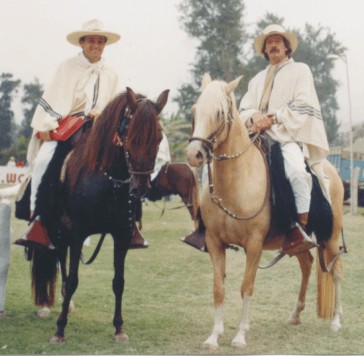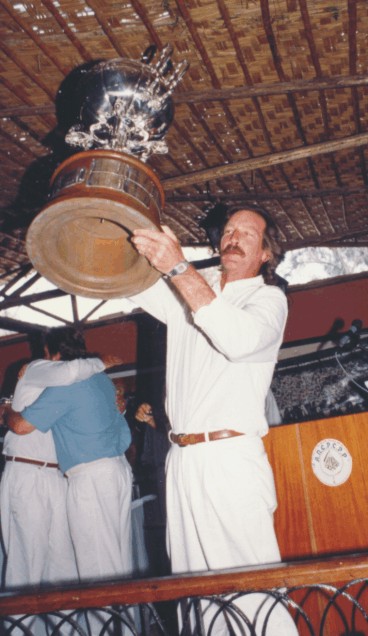movements are executed. The elasticity, the naturalness, the harmony, the manner of impulse in the dissociation of the hoof-beats and the duration of the times of sustentation and suspension are the elements that will define the different qualities of “piso”.
The whole process of creation and definition of our horse had as a golden rule the search for and improvement of the fundamental characteristic of the breed: its “piso”. This singularity, characteristic of the breed, is not the only difference between the Peruvian horse and other equine breeds; they are also to be found in its origin and in the selection without crossings with foreign breeds, which produced over time a phenotype consequent with the usefulness of the function and the unique gait of the breed. These other differences will not be subject to analysis in this article, considering them to be irrelevant to the subject being discussed.
We know that the origin of our horse is preceded by centuries of genealogies of Berber blood, this being inevitably so, when the perfect amble of the Berber was being decanted in Spanish and Peruvian lands. This would be changed into the dissociated amble with front leg action from which the Peruvian Paso or piso was derived. It should be noted that the first horse to reach the Spanish Americas had the Castillian Paso as an unmistakable Berber influence acquired in Spain during the centuries previous to the encounter with Peru, bringing with it also the genetic baggage of the primitive horse of the Celts, the Thieldon.
In 1492 two events took place that were vital to the creation of the Peruvian horse and that would permit its evolution which was just beginning in the land of an awakening Peru. The first of these events was the defeat of the last redoubt of Boabdil, leader of the empire of the crescent moon, and the second was that in October of that same year America was discovered. From the moment of that second event, world history was changed forever. There are changes in trade relations, in the axes of power, knowledge increases, religious concepts are exacerbated, a different destiny awaits the second sons and adventurers of the whole world and, in so far as if of interest to us, this last happening opened the doors to the arrival of the spirits of Quixote and Sancho in unconquered America. Extreme lines of Spanish thought in the 16th and 17th centuries.
The criollo man born in Peru chooses the spirit of Don Quixote as a symbol of the creation of the impossible, and the spirit of Sancho Panza of the discovery of the usefulness of function.
With the appearance of these extreme ideals in Peru, the task begins of gathering in a single race the horse of great front leg action with the horse of pure function.
This magic would have been impossible had it not been for Ibero-American sensibility forged in Peru by men of mixed race born under the influences of the meeting and clashing of cultures. Then and now, we can see the spirit of Quixote searching for the last mirage of the impossible, in the “piso” and the spirit of Sancho searching for the usefulness of the “piso’s” function – in the Paso.
Much time had to go by before defining the preferences of the one and the other, and from that agony of each one seeking its limits, arises that Castillian Paso horse that came to Peru, the horse celebrated in history and in criollo sensibility – the Peruvian horse.
In the title of this essay, I write that the function of piso lies in the pace, and I add to that saying that the mirage of Don Quixote will lie in the usefulness that Sancho was searching for. These aspects are interdependent; without Quixote, Sancho would not exist. They are concave and convex spirits that depend on one another and that when joined form a whole, as light with darkness, as the whole with nothing, and as the piso with the Paso.
The Peruvian horse displays today sophisticated natural dynamics when moving, achieved through the process of selection to which it was submitted when the race came from Europe. So one can ask oneself, “were selection and evolution forged through Paso or through Piso?”
On imagining the utilitarian past of our horse, one would be obliged to refer to its travelling origins and the agrarian labors in which it was employed in the recent past. We know that the journeys undertaken in the deserts separating the coastal valleys of Peru were made al Paso (pace) and in some stretches with the air of the piso, that is, ambladura; likewise it is known that in the cultivated valleys the overseers and owners rode in the fields with the Paso air. Perhaps they were imitating the speed with which the waters irrigate the fields of cotton and other crops, using only the piso air, at the gallop or in perfect ambling, when some special circumstance called for it.
In the deserts and valleys, Sancho rode oftener than Quixote, while in the fiestas, on entering the little towns and on other special occasions for showing off, only Quixote rode, with his mirage. Some may believe that I am mistaken in my interpretation because they rode the valleys and deserts only with high lift action and this is true. Moreover, it must be born in mind that the journeys to which I refer last more than a day and often these are days of eight or more hours, so the mounts are obliged to adopt an air that is energy saving. It could also be said that there have been memorable travelers who rode at the speed of centaurs but these were in the minority and the minority cannot determine selection by function, for the majority.
The piso as a natural air is not for long journeys; suffice it to recall the amount of energy squandered by our horses when they use that particular air. To illustrate this, let us compare the Paso of our horse with the human voice, and the piso with songs, with the result that we would have to ask humans to sing when they talk or to talk when they sing, confusing the natural expressions with the functions to which these natural forms are destined.
The air of piso, with its naturalness and elasticity of movement is fundamental in the usefulness of the function of the Paso; however, the former could not be the natural air for traveling, just as singing is not for conversation.
In the Paso llano gateado (crawling) the Peruvian horse manages to stretch itself out in its movements as no other horse can do while using the Paso, the piso being then the generator of the excellence of the traveling Paso. He who can do most with the greatest can do so with the least. Contrary to the above that expressed in horses of ordinary piso, the extension in the Paso will be very short, failing in excellence of traveling function. He who can only do the least cannot undertake the greatest.
When we ride our horse with the piso air we will be accompanied by the spirit of Quixote and will together be touching the unreachable line of the horizon... getting near to God. When we ride with the Paso air, we will be harboring Sancho’s spirit heading for our travel destination but nothing more.
I am convinced that just as song is the sublime expression of music and the voice, in the Peruvian horse the piso air is a blend of the impossible with usefulness of function. The concave and the convex of the spirits of the Quixotes and Sanchos merged in the creation of our horse and so, without more ado, I reaffirm that the function of piso is – through Paso.
P.S. The US National Show of 2001 in which I had the opportunity to act as judge, I was accompanied by my friend Bruno Passini, to whom I promised this article. Let it serve to thank him publicly for the thousand and one courtesies he showed me and I hope that this essay will provoke in him and others who read this, the “useless” subtleties of thought.


